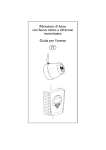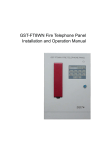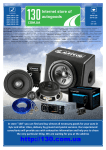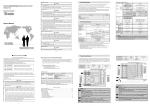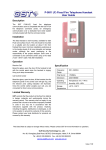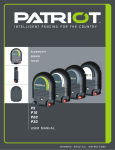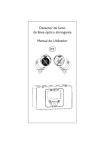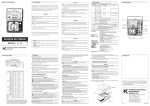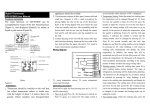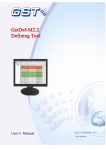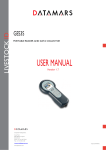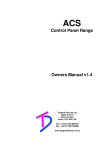Download Conventional Photoelectric Smoke Detector
Transcript
C-9102 (UL) Conventional Photoelectric Smoke Detector Installation and Operation Manual (Issue 1.04, July 2012) C-9102 (UL) Conventional Photoelectric Smoke Detector Installation and Operation Manual CONTENTS I II III IV V VI VII VIII IX X General ................................................................................................................ 1 Features ............................................................................................................... 1 Technical Specifications ....................................................................................... 1 Structure and Operation Principle ........................................................................ 2 Mounting and Wiring ............................................................................................ 2 Testing .................................................................................................................. 4 Troubleshooting ................................................................................................... 5 Maintenance ......................................................................................................... 6 Cautions ............................................................................................................... 6 Quality Warranty .................................................................................................. 7 C-9102 (UL) Conventional Photoelectric Smoke Detector Installation and Operation Manual I General C-9102 (UL) Conventional Photoelectric Smoke Detector (hereinafter called the detector) is a non-addressable detector, applicable to hotels, restaurants, office buildings, teaching buildings, banks, warehouses, libraries, computer rooms and switch rooms, etc. It can be connected with compatible fire alarm control panel (FACP) through a 4.7kΩ terminal resistor to detect fire. II Features The detector adopts the latest scattering technology and excellent photoelectric components, improving the reliability, stability and conformity of the sensor. With special optical sensing chamber, it has high ability of insect-proof, dust-proof, and interference-proof of external rays. With novel structure and attractive appearance, the detector has stable and reliable performance and high damp-proof ability. III Technical Specifications 1. 2. Operating Voltage: 12VDC~28VDC Operating Current: Standby Current:≤60μA Alarm Current: 10mA≤I≤30mA (Note: The alarm current depends on the current limit of the FACP. It’s not allowed to power the detector directly by 24VDC. Otherwise the detector will be blown as a result of without current limiting resistor.) 3. 4. 5. 6. 7. Alarm Reset: Instantaneous Cut-out (5s MAX, 2.5VDC MAX) Initiating Time:≤10s Sensitivity:1.23%/ft~2.02%/ft Maximum Ripple Voltage: 4V(peak-to-peak value) Alarm Confirming LED: Red, not lit when in normal operation, constantly lit when alarming. Monitoring Area: When space height is 6m~12m, the monitoring area of a detector is 80m 2 for normal protection area; When space height is less than 6m, it is 60 m 2. Wiring: Connecting with the power cable by polarized two-wire. Operating Environment: Temperature: 0℃~37.8℃ (UL268) Relative Humidity:≤95%, non-condensing Dimension: Diameter: 100mm Height: 42mm (without base) Diameter: 105mm Height: 56mm (with base) Ingress Protection: IP22 Material and Color of Enclosure: ABS, ivory white Weight: About 120g Matching Parts: DZ-03 Base Standard Applied: UL268 8. 9. 10. 11. 12. 13. 14. 15. 16. Page 1 C-9102 (UL) Conventional Photoelectric Smoke Detector Installation and Operation Manual IV Structure and Operation Principle 1. Appearance of the detector is shown in Fig. 1. Fig. 1 Appearance 2. Operation Principle The detector detects fire by scattering of infrared beam, whose circuit is consisted of infrared beam emitting part and receiving part. The emitting diode and photodiode are in the optical sensing chamber, which can screen interference of outside light without preventing entrance of smoke particles. In smokeless condition, it only receives very weak infrared light; When smoke particles enter, the received light signal increases by scattering; When smoke reaches certain density, it can output alarm signal. To reduce interference and power consumption, the emitting circuit works intermittently in order to increase the life of emitting diode. Alarm output signal works on current mode, for series connection of several detectors and checking of fault and fire. V Mounting and Wiring Warning: Before installing the detector, disconnect the power from the loop and verify that all bases are securely installed and that the wiring polarity is correct at each base. 1. Mounting of the detector is shown in Fig. 2. Page 2 C-9102 (UL) Conventional Photoelectric Smoke Detector Installation and Operation Manual Wiring Tube 上盖 防尘罩 Embedded Box 防虫网 迷宫 Orientation Base 螺钉 Detector 探测器底部 2. Fig. 2 Mounting Bottom and base of the detector is shown in Fig. 3 and Fig. 4. Record Label A B DZ-03 C Mounting Hole Fig. 3 Bottom of the detector Fig. 4 Orientation base 3. Wiring Method The base of the detector is DZ-03 Base produced by GST. The bottom of the detector and the orientation base are shown in Fig. 3 and 4. There are four terminals with numbers on the base, “1” connects with the anode of the output end of compatible FACP, “2” connects with terminal No. “1” of the next base as output, “3” connects with terminal No. “3” of the next base and the cathode of the output end of compatible FACP, “4” doesn’t connect to any wires but is used to fix the detector accessorily. A 4.7k/1w terminal resistor can be connected between terminal “2” and “3” of the last base in a loop. System connection is shown in Fig. 5. Page 3 C-9102 (UL) Conventional Photoelectric Smoke Detector Installation and Operation Manual Output+ 4.7k Terminal Resistor Compatible FACP Output- DZ-03 Base DZ-03 Base CAUTION: DO NOT USE LOOPED WIRE UNDER TERMINAL 3. BREAK WIRE RUN TO PROVIDE SUPERVISION OF CONNECTIONS. Fig. 5 Wiring 4. Mounting There are location elements on the detector and the orientation base to ensure there is only one installing position. There are two marks on point A and B of the orientation base, and a mark on point C of the side face of bottom of the detector. When installing, aligning the mark C of the detector to point A of the orientation base, rotate the detector clockwise to point B, then the detector is installed. The detector base is designed with anti-tamper function. After installing the detector onto the base, twist a ST2.9X6.5 cross recessed pan head tapping screw into the hole on the side of the base to prevent removal of the detector. Then the detector can only be removed after twisting off the screw by a screwdriver. (Note: Please use this function only when necessary to avoid trouble in maintenance and repair.) 5. Location and Spacing 1) The horizontal distance from the detector to the wall or the girder should not be less than 0.5m. 2) There should not be any obstruction within 0.5m around the detector. 3) The horizontal distance from the detector to the blast hole of any air-conditioner should not be less than 1.5m; that to the multi-hole ceiling blast should not be less than 0.5m. 4) When installing detectors on corridor ceilings not wider than 3m, they should be placed in the middle. The spacing should not be more than 15m. The distance from the detector to end wall should not be more than half of the spacing. 5) The detector should be installed horizontally. If it has to be installed aslant, the gradient angle should not be more than 45o. 6. Wiring: 227 IEC 06 cable with cross section not less than 1.0mm 2. VI Testing Warning: Power up only after all devices are well connected. 1. 2. 3. Before testing, notify the proper authorities that the system is undergoing maintenance and will temporarily be out of service. Disable the zone or system undergoing maintenance to avoid unwanted alarms. Test the detector after installation and regular maintenance. Test Method Page 4 C-9102 (UL) Conventional Photoelectric Smoke Detector Installation and Operation Manual 1) Field testing can be done by Trut300 Smoke Detector Sensitivity Tester of No Climb Products Ltd. (for detailed description, please refer to Trutest Smoke Detector Sensitivity Tester User Manual Issue2.1c) or similar smoke generating tools. If Trut300 is used, adjust its obscuration to 1.7% /ft to 2.6% /ft according to the manual, start testing until the detector alarms. If the tester shows “pass”, the detector passes the test. 2) You can also use similar smoke generating tools (cigarette or smoke gun) and blow the smoke at the smoke-in hole (Fig. 6) into the detector until it alarms. Note: This test is only used for verifying the ability of the detector to alarm after smoke enters. It cannot be used to test its sensitivity. LED Smoke in Recess 4. 5. Fig. 6 Testing After testing, reset the detector by power-cut over 5s. Notify the proper authorities the system is back in operation. If a detector fails in testing, clean it as described in "Maintenance" and test again. If it still fails, please return it for repair. VII Troubleshooting In case of any fault, check connecting cables and fixing screws first, then open the housing to see if there is loose soldering or blown parts. Possible trouble and solution during operation are as follows: 1. No alarm: Check whether the detector is securely installed on the base. There should be DC24V voltage on terminals No. 1 and 3 of the base, if not, check the cable with the FACP open or not. 2. Nuisance alarm: Check the LED on the detector lit or not. If not, check the polarity of wiring and whether there are short circuits on terminating resistor. If it's lit, check whether the chamber in the detector is too dirty and needs to be cleaned. Otherwise, the circuit may be broken. Page 5 C-9102 (UL) Conventional Photoelectric Smoke Detector Installation and Operation Manual VIII Maintenance 1. 2. 3. The detector should be cleaned at least once a year to ensure normal operation of the system. Before cleaning, notify the proper authorities that the system is undergoing maintenance and will temporarily be out of service. Disable the zone or system undergoing maintenance to avoid unwanted alarms. Remove the detector to be cleaned. Take down the top cover by prizing along the three recesses with a minus screwdriver and clean the dust on the insect net by a vacuum pump or cleaner; if there is too much dust or it cannot be totally cleaned, you can take down the sensing chamber and pull out the insect net along axle, clean or replace the insect net, then remove the dust on the sensing chamber by vacuum pump or cleaner, and re-install the insect net and sensing chamber (note to install them to the end). Align the orientation marks on the two parts of enclosure and re-install the top cover. See Fig. 7. Orientation Mark Sensing Chamber Insect Net 4. Fig. 7 Cleaning Test the detector again after re-installation. IX Cautions 1. 2. The dust cover cannot be removed until the project has been put into usage. It should be well kept for future use. Dust covers are an effective way to limit the entry of dust into smoke detector sensing chambers. However, they may not completely prevent airborne dust particles from entering the detector. Therefore, we recommend the removal of Page 6 C-9102 (UL) Conventional Photoelectric Smoke Detector Installation and Operation Manual detectors before beginning construction or other dust producing activity. Be sure to notify the proper authority for the removal of the detectors. 3. In maintenance, note to be careful to avoid damage to the detector. 4. The detector may not sense fire that starts where smoke cannot reach it such as in chimneys, in walls, on roof, or on the other side of closed doors. 5. The detector cannot detect fire beyond its monitoring area. 6. The detector may not alarm in time for fire caused by inadequate fire protection measures, explosion, gas leakage, arson and children playing with fire. 7. In high velocity environment, the alarm may be delayed by dilution of smoke density due to frequent and fast air exchange. 8. The detector has a limited life. To ensure the detector is always in good operation state, please maintain it according manufacturer’s recommendations and relative national code. 9. The detector should be tested regularly, at least once a year. X Quality Warranty This detector is approved by UL as a recognized component. It’s strongly recommended that fire alarm control panel manufacturers intending to use this detector in their fire alarm systems to verify system compatibility before application in order to avoid system failure. Gulf Security Technology Co., Ltd. warrants that the detector will be free from defects in design, materials and workmanship. The warranty is valid for a period of 2 years from time of dispatch. This warranty shall not apply to any product that is found to have been improperly installed or used in any way not in accordance with the instructions supplied with the product. Anybody, including the agents, distributors or employees, is not in the position to amend the contents of this warranty. Products not covered by this warranty shall also be returned for repair. Please return the products together with a description of fault and possible reason to No.80 Changjiang East Road, QETDZ, Qinhuangdao, Hebei, P.R. China, Gulf Security Technology Co., Ltd. Postcode: 066004. Page 7 Gulf Security Technology Co., Ltd. No. 80, Changjiang East Road, QETDZ, Qinhuangdao, Hebei, P. R. China 066004 Tel: +86 (0) 335 8502434 Fax: +86 (0) 335 8502532 [email protected] www.gst.com.cn 30302468












